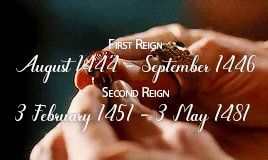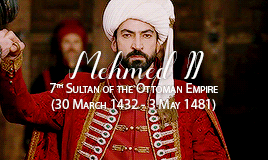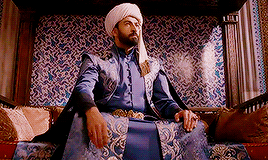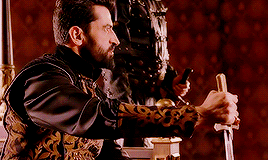A blog about Medieval Times and Europe. I personally think it is one of the most overlooked and misunderstood times in our history. My cut-off point will more or less be 1500 generally or Bosworth (1485) for England, but I will go ahead sometimes.
Don't wanna be here? Send us removal request.
Photo






Ruairi O’Connor as Henry VIII in ‘The Spanish Princess’
195 notes
·
View notes
Photo






Florence Pugh as Elizabeth Burgh in ‘Outlaw King’
101 notes
·
View notes
Photo

Crossbow Brooch, Medieval Art
Purchase, The Kurt Berliner Foundation Gift, 2001 Metropolitan Museum of Art, New York, NY Medium: Cast copper alloy with silver inlay
30 notes
·
View notes
Text
I think that the whole “medieval Europe didn’t produce anything great and was filled with ignorant and superstitious peasants with no culture or scientific knowledge and was able to become civilised by stealing Asian and African ideas” may be one of the most irritating theories Americans have come up with in recent years.
#not sure if it's just an american thing#but this is true nonetheless#medieval#yep pretty much#medieval europe
221 notes
·
View notes
Text
A Knight in shining armor is a man whose metal has never been tested.
34K notes
·
View notes
Photo

Leaf from a Beatus Manuscript: the First Angel Sounds the Trumpet; Fire, Hail-stones, and Blood are Cast Upon the Earth, The Cloisters
Purchase, The Cloisters Collection, Rogers and Harris Brisbane Dick Funds, and Joseph Pulitzer Bequest, 1991 Metropolitan Museum of Art, New York, NY Medium: Tempera, gold, and ink on parchment
http://www.metmuseum.org/art/collection/search/466203
165 notes
·
View notes
Photo






Favorite Costumes
From: The White Princess
Character: Cathy Gordon
193 notes
·
View notes
Photo



On this day in history
Fernando to Isabel
My Lady. After having the other note written, I received a letter from the king, my Lord [John II of Aragon], which I send you, my Lady. By which you will see how the matters in Elna are, and how he orders me to come with all the people of this kingdom to aid this city. Seeing this I can not express my sorrow; I think that if I were in hell, I would suffer much less than I do now, and so many times I wish myself death that I think my thoughts may be fulfilled, I don’t know why Our Lord gave me so much good and so little time to enjoy it, since, for three years, I have not been with you, my Lady, at times even seven months in a row. Now I have demonstrated and I say that I have to go to make them move more in order to do the service, which can not be faster than before Christmas, and if during this time you, my Lady, could make the King [Henry IV of Castile] call me to be sworn in [he is referring to the swearing-in as the Princess heiress of Castile and her consort], I would quickly come, but otherwise, I don’t think I would have an excuse for the King, my lord [John II of Aragon]. However, I will do everything that is in my power to be able to come, but this bad honor [charge of Lieutenant in Aragon which did not let him join his wife] makes me feel so bad that what I am saying does not make sense. I beg you, my Lady, the archbishop [of Toledo] and Cardinal [Mendoza] to help me in this matter, I don’t ask your Ladyship because you have enough yourself, and don’t you think, my Lady, that I need something more than your order [to come to Castile], I would come but for now, other reasons are required. I beg you, my Lady, to forgive me because being angry and disturbed I don’t know what I am saying, I will delay my departure until I get a response from you, my Lady, which I beg you to be soon, and it is how this slave of Your Grace concludes, The Prince-King [Prince of Aragon and king of Sicily]
[Zaragoza, December 1st, 1474]
Direction: To My Lady
Source: Cartas autografas de los reyes catolicos de España Don Fernando y Doña Isabel que se conservan en el Archivo de Simancas, 1474-1502, letter nr 1, Amalia Prieto Cantero
The gifset inspired by @thenameismg
#letters#ferdinand of aragon#isabella of castile#isabella i of castile#ferdinand ii of aragon#Spanish History#spanish monarchy#spanish royalty#spain#history#early modern#renaissance
117 notes
·
View notes
Photo








Elizabeth of York requested by @margarettudor
631 notes
·
View notes
Text
The chronicle of the monk Herbert of Reichenau for the year 1021 ends “My brother Werner was born on November 1.“
1021 was not an uneventful year. The emperor began a campaign into Italy. Illustrious abbots died. There was an earthquake. But Herbert took the time to note, at the end of the year, that his brother was born.
Of such acts of tenderness is history made.
#this is why I love history okay?!?#especially history#*especially.medieval history#the queue is dead long live the queue#history#medieval history#mmedoe#medieval#lol#funny#parenting#sort of
122K notes
·
View notes
Photo








History Week Meme | Day 5: one man → Mehmed the Conqueror
“The conquest of Constantinople gave the Ottoman Empire a capital city at the juncture of its European and Asian territories, securing the Straits which linked the Black Sea and the Mediterranean. Through his victory, Mehmed acquired spiritual prestige as the conqueror of the city foretold in Muslim eschatological tradition, and secular glory as heir to the throne of the Caesars. Furthermore with his appointment of George Scholarios — a prominent anti-unionist cleric — as Patriarch, he asserted his primacy over the Greek Orthodox Church. It is for his conquest of the city that Mehmed II remains famous, but it was only the beginning of the incessant warfare that marked his reign.” - Colin Imber; The Ottoman Empire
“In his thirty years in power Sultan Mehmed had fought eighteen campaigns in person. The Ottoman Empire which he created was an extensive mass of land and sea which sat at the hub of the great trading networks of the time. Moribund and depopulated, Byzantine Constantinople had been remade as the flourishing capital of territories that included the Balkan peninsula as far as the Adriatic in the west, the Danube-Sava line in the north, and most of Anatolia. The Black Sea coast marked a relatively safe frontier beyond which there were at this time no states capable of threatening Ottoman power. Rivals still threatened to east and west, but within the limits of Mehmed’s state a pax ottomanica brought a measure of internal security which was disturber only by localized brigand activity on land and corsairs at sea.” - Caroline Finkel; Osman’s Dream: The History of the Ottoman Empire
#ottoman empire#ottoman history#quotes#caroline finkel#mehmed the conqueror#screw him tbh#mehmed ii#sultan mehmed ii#history#biography#late medieval#early renaissance#turkey
299 notes
·
View notes
Photo

On November 28th in 1509 Ferdinand wrote to his daughter Katherine, informing her that he had received her epistles and had had much pleasure in reading all of them, especially as he had learnt by them that she was with child. Her pregnancy was a great blessing, since she, her husband, and the English people had wished it so much. May God give her a good delivery. He would continually pray the Almighty to grant his prayers till he was informed that she gave birth to her child. Begged her to be careful of her health. During her pregnancy she needed to avoid all exertion, and especially not write with her own hand. With the first child it was requisite for women to take more care of themselves than was necessary in subsequent pregnancies, he told her.
(x)
#history#Spanish History#spajm#spain#Spanish monarchy#spanish royalty#catherine of aragon#ferdinand of Aragon#ferdinand ii of aragon#early modern#renaissance#letters
116 notes
·
View notes
Text
Resources of Interest for Early Modern Magic in England & New England (circa the 1500s to 1800)
Primary Sources
The Key of Solomon. I’ve heard a lot of good things from several ceremonial magicians, including @thedesertgod , that the edition to go for is Skinner’s. He’s compiled, edited, and added scholastic commentary to The Veritable Key of Solomon, as well as The Magician’s Tables. Joseph Peterson, also recommended, has worked on The Lesser Key of Solomon and the Clavicula Solomonis (or Key of Solomon). I probably would read it in its original Latin, if you have the means.
Agrippa, Cornelius (false attribution). The Fourth Book of Occult Philosophy. 1655. Stephen Skinner also worked on an edition of this book. Unlike the actual Agrippa’s original three books, this volume does not hold much in the way of theory but offers plenty of practical instruction.
Casaubon, M. A True and Faithful Relation of what passed for many years between Dr. John Dee…and Some Spirits. 1659. As a record of the seances held by Dr. Dee and Kelley, it recounts the techniques used to conjure spirits.
Chamberlain, Richard. Lithobolia. 1682. One family’s account of witchcraft perpetuated by the fetch of a neighbor.
Culpepper, Nicholas. Complete Herbal. 1653. It provides a comprehensive description of the herbs, along with their medicinal uses and instructions on preparing them to treat illnesses.
Culpepper, Nicholas. The English Physician. 1652. The first medical guide published in the American colonies (apparently), it is intended for the average person.
Defoe, Daniel (assumed). A Compleat System of Magick; or, The History of the Black-Art. 1727. As a skeptic, like Reginald Scot, this anonymous author (who we’re pretty sure is Defoe) provides much information on the work of witches, conjurors, and cunning-folk.
Hale, John. A Modest Enquiry into the Nature of Witchcraft. 1702. After the Salem witch trials, he challenges the legal proceedings and religious principals of witch hunts in general.
Magnus, Albertus (false attribution). The Book of Secrets. “Provides a portrayal of the magical culture that predominated in the 16th century. This work includes secrets which are divided into five distinct parts: Of the Virtues of Herbs, Of the Virtues of Stones, Of the Virtues of Beasts, Of the Planets, and The Marvels of the World.”
Mather, Cotton. Memorable Providences. 1698. Having fanned the flames of the Salem hysteria, this book discusses several witchcraft cases in New England before the Trials arose.
Mather, Increase. Cases of Conscience. 1693. Intended to vindicate the Mathers’ involvement in Salem, it was intended to prove that witches and devils could assume the shape of an innocent person.
Scot, Reginald. The Discoverie of Witchcraft. 1584. By attempting to debunk witchcraft as a hoax, it managed to record a good cross-section of their formulae.
Turner, Richard. Botanologia The Brittish Physician: or The Nature and Vertue of English Plants. 1664. Another guide to British herbs and medicine, by an astrologer, occultist, and botanist.
Modern Accounts
Davies, Owen. Cunning-Folk: Popular Magic in English History. Hambledon and London, 2003.
Demos, John. Entertaining Satan: Witchcraft and the Culture of Early New England. Oxford University Press, 2004.
Godbeer, Richard. The Devil’s Dominion: Magic and Religion in Early New England. Cambridge University Press, 1989.
Merrifield, Ralph. The Archaeology of Ritual and Magic. Batsford, 1987.
Semmens, Jason. The Witch of the West: or, the Strange and Wonderful History of Thomasine Blight. Semmens, 2004.
Thomas, Keith. Religion and the Decline of Magic. Peregrine, 1978.
Weisman, Richard. Witchcraft, Magic, and Religion in 17th-century Massachusetts. University of Massachusetts Press, 1984.
Wilby, Emma. Cunning Folk and Familiar Spirits: Shamanistic Visionary Traditions in Early Modern British Witchcraft and Magic. Sussex Academic Press, 2005.
2K notes
·
View notes
Quote
“The French queen [Henrietta Maria, daughter of Henry IV of France], who was small and childlike, delighted in acting for the king with her ladies. These Renaissance inventions were fantastic court entertainments, almost like plays, with elaborate costumes, and with lines usually written by the playwright Ben Jonson. Despite growing Puritan disapproval of play-acting, vehemently expressed in sermons and pamphlets, Charles’s court was famous for its amateur theatricals. These masques tended to have for their theme the divine majesty of the king, which had a special appeal to Charles as he was intensely religious.
Rebecca Fraser, The Story of Britain: From the Romans to the Present: A Narrative History, 327 (via early-modernism-research)
#Rebecca'#rebecca fraser#quotes#henrietta marie#the story of Britain: from the Romans to the present: a narrative history#327#pg. 327#Stuarts#stuart#bourbon#early modern#renaissance#England#france#bourbons#charles i
36 notes
·
View notes
Photo

Victims of the Childbed - Jadwiga, King of Poland
In 1373, King Louis “The Great” of Hungary and his wife Elizabeth of Bosnia welcomed their third child. After the births of two daughters and twenty years of marriage it was hoped that Queen Elizabeth would finally bear a male heir to her husband’s empire. Instead, the baby was a third daughter. She was christened Hedvig after her ancestor, Saint Hedwig of Silesia. History would know her by the Polish version of her name – Jadwiga.
Jadwiga spent her early years at her parents’ court at Buda, which was a major cultural center. From early childhood Jadwiga and her older sisters, Catherine and Mary, received an education that was among the best available in Europe. Following the early death of Princess Catherine, Mary and Jadwiga became the only immediate heirs to Louis’ dominion of Hungary, Poland, and Croatia. As such the young princesses were highly valued brides among the European royal houses. When she was around the age of five, little Jadwiga was “married” to eight-year-old William of Habsburg in a false ceremony that would be fully realized once the couple came of age. It was planned that Jadwiga and William would rule Hungary, while Princess Mary and her betrothed, Sigismund of Luxembourg, would rule Poland.
The noblemen of Poland were opposed to being ruled remotely, therefore they required that one of Louis’ daughters settle in Poland if she was to rule there. In September of 1382, Jadwiga was present at Louis’ bedside when he died. From there events moved quickly and Mary was crowned King of Hungary instead of Jadwiga. Poland now refused to have Mary as their ruler, for she would not reside in the country. Several male claimants to the Polish throne were put forth, but Jadwiga seemed to have the strongest claim. Queen Elizabeth, now regent of Hungary, was rather reluctant to part with Jadwiga so soon. Meanwhile, internal strife had broken out in Poland during this interregnum. In order to quell the unrest in the country, Jadwiga was finally sent to Poland in October 1384. She was crowned as King in Kráków without opposition. Though only eleven, Jadwiga was noted for her mature intelligence, kindness, and piety. She was soon extremely popular in her new country.
Now that she was the ruler of Poland, Jadwiga’s marriage became a matter of great importance. She was still technically married to William of Habsburg but the union was unconsummated and could therefore be easily broken. The lords of Poland favored a match with Jogaila, the pagan Grand Duke of Lithuania. According to legend, William was forced out of the castle on the night he was to consummate his marriage to Jadwiga. Upon hearing of this, Jadwiga called for an ax and attempted to break open the castle gates herself in order to reach William. Whether this is based in fact or is simply popular legend (she was only around the age of twelve), William was indeed sent from Poland and was never fully Jadwiga’s husband.
It is said that Jadwiga received divine inspiration during prayer that convinced her to wed Jogaila of Lithuania. Jogaila vowed to convert himself and the people of Lithuania proper to Catholicism. On February 18, 1385, twelve-year-old Jadwiga married thirty-five-year-old Jogaila. The marriage united Poland with the massive territory of Lithuania, which at that time comprised most of present-day Ukraine and Belarus. Jadwiga and her husband, now baptized as Władysław II Jagiełło, ruled jointly instead of as king and consort. As she matured, Jadwiga became even more beloved by her people and developed her skills as a mediator and political negotiator, but she never lost her sense of compassion. During a royal visit to Greater Poland there was damage done to many peasants and their homes. Jadwiga convinced Jogaila to compensate them, telling him “We have indeed returned the peasants’ cattle, but who can repair their tears?”
Though Jadwiga and her husband were an effective team, she also acted independently. Following the worrying spread of anarchy in Hungary and the subsequent murder of her mother in 1387, Jadwiga rode at the head of her army and secured the submission of the Ruthenian governors in the midst of the chaos. Throughout the 1390’s Jadwiga played a vital role in politics and was known to be an astute politician and impartial mediator with peace being her main objective. Jadwiga was also deeply pious and devoted to the spread of Christianity in Lithuania. Perhaps her greatest achievement was the development of Jagiellonian University. The university was originally founded by Casimir III but did not continue after his death. Under Jadwiga it was reborn, renamed, and still exists today. Jadwiga personally donated her jewelry to afford tuition for 200 students.
After twelve years of marriage, Jadwiga and Jogaila had no children. This may have caused tension in the relationship, as both monarchs were in need of an heir. Jadwiga became pregnant by late 1398. Hopes were high and astrologers predicted the birth of a son. On June 22, 1399 Jadwiga gave birth. Instead of the expected boy, Jadwiga’s child was a girl, but still her heir. The baby girl was christened Elizabeth Bonifacia after Jadwiga’s mother and Pope Boniface IX, who had agreed to be the godfather. Any gladness or relief was dashed when Elizabeth died just three weeks later. Jadwiga never recovered from the birth and lingered for nearly a month afterwards. She died on July 17, 1399. Jadwiga was greatly mourned and regarded as the mother of her country. In recent years, she has been compared to Casimir the Great as one of Poland’s greatest rulers. Jadwiga was officially canonized in 1997. Her tomb in Wawel Cathedral is now a holy shrine.
276 notes
·
View notes
Photo




203 notes
·
View notes
Photo










Now in the fall of 1469, Fernando was resolved to marry the princess of Castile. He immediately left for Valladolid with Cárdenas and Palencia, accompanied only by a few retainers. Riding mules, the small band traversed hostile countryside disguised as merchants and their servants. Wherever they stopped, Fernando, playing the servant, served supper and curried the mules. Along the way, the riders were much cheered when Palencia spotted a good omen, a pair of eagles, soaring high. At the border town of Burgo de Osma they found Gómez Manrique waiting; Isabel had sent him with a squadron as escort. On October 9, in Valladolid, she received Palencia and Cárdenas, who had ridden ahead to let her know that Fernando had arrived at nearby Dueñas, had been royally received by Buendía, Carrillo’s brother, and the countess, Fernando’s aunt, and that he was safe and on his way. Her happiness was intense, recounts Palencia, not least because while waiting she had had to cope with arguments against the wedding put to her by envoys of Pacheco and Queen Juana, both of whom by then knew something was in the wind. Isabel had to fend off as well some of her own courtiers, who insisted that the dignity of the royal house of Castile and the excellence of the princess far exceeded that of the king of Sicily and prince of Aragón, and it was unfitting that, through being male, he should enjoy any advantage whatsoever over his spouse. On October 12, Isabel wrote to Enrique: “By my letters and messengers I now notify Your Highness of my determined will concerning my marriage,” which at her age she adjudged to be a very reasonable event. In view of who she was, she went on, and whose daughter and whose sister, she had made the most suitable match possible, after having consulted the principal people of the realm. She wrote only now because she had been informed that Enrique, “following the counsel of some,” had sought to intercept Fernando, who, she wanted him to know, had arrived at Dueñas. Have him as a good vassal, she urged Enrique, and approve her intention. Then came that frustrating phrase that occurs so often: Her secretary who was bringing that letter would inform him further. Two days later, she and Fernando met for the first time. He came to Valladolid from Dueñas, secretly, with only three retainers, in the middle of the night, and entered the house by a postern gate. Carrillo greeted him—the archbishop tried to kiss his hand but Fernando instead embraced him—and led him inside to meet Isabel. As they entered the room, Cárdenas excitedly pointed him out to her: ¡ése es, ése es!—that is he, that is he! Cárdenas, as authorized by Isabel, ever after proudly bore two ss emblazoned on his coat of arms. Isabel was eighteen, auburn haired and comely, her blue-green eyes steady. From all indications she was tall and stately, her bearing regal. (Her surviving portraits show only a much older and ill queen). She saw enter the room a gallant youth, eyes sparkling, taut with energy, a cousin, and a very welcome one. She and he talked for two hours. “The presence of the Archbishop repressed the amorous impulses of the lovers,” according to Palencia, “though they soon enjoyed the licit joys of matrimony.” By all accounts, theirs was an instant attraction, and, remarkably, it proved a passionate and long-lasting love. A notary took down their formal promises to marry. Fernando gave Isabel customary, if unspecified, gifts and that night he returned to Dueñas. Peggy K. Liss, “Isabel the Queen: life and times”.
#quotes#isabel the queen: life and times#Peggy K. Liss#Spanish History#Spanish monarchy#spanish royalty#history#isabella i of castile#isabella of castile#early modern#renaissance#ferdinand ii of aragon#ferdinand of aragon#spain
179 notes
·
View notes